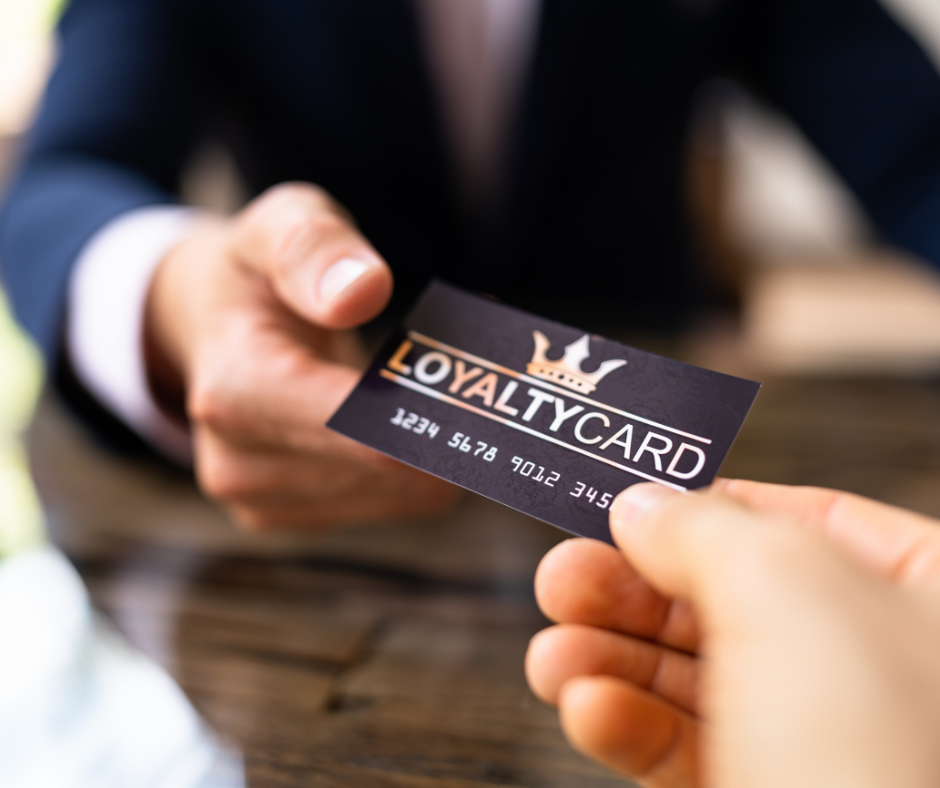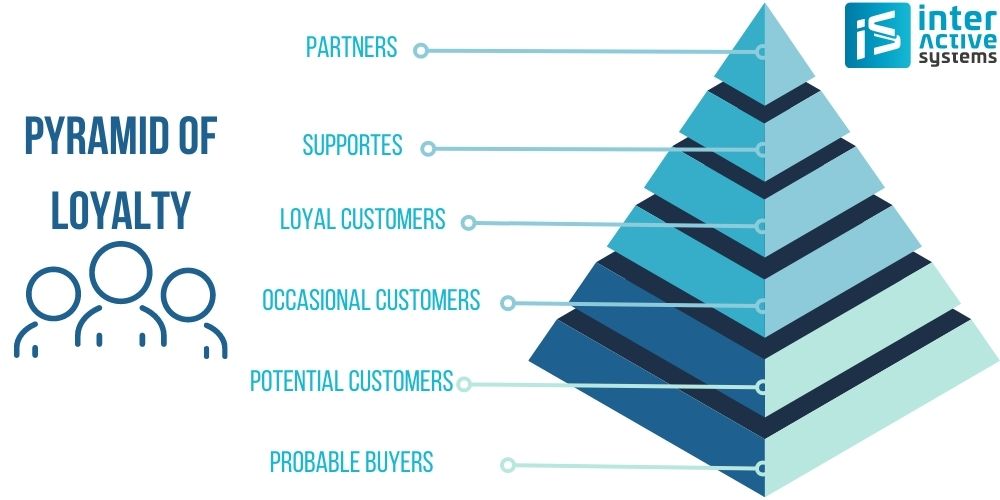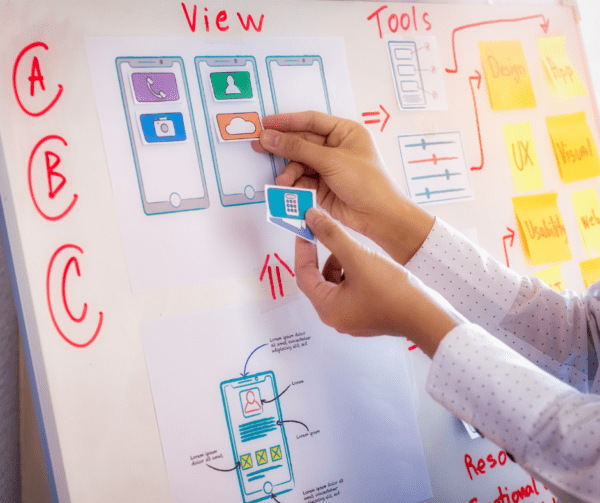Loyalty pyramid vs. profits generated

Customer loyalty is a key element of success in today’s business, as it affects both sales policies and profits generated. A loyal consumer is not only a regular buyer, but also a brand ambassador, attracting new users. Let’s learn about types of loyalty and the consumer loyalty pyramid – an analysis and planning tool.
In modern business it is essential to have regular, loyal customers. This type of consumer not only shapes sales policy, but also has a huge impact on the profits generated. This article describes what loyalty is, its graphical representation, its benefits and the costs it brings to a company.
Consumer loyalty
A loyal customer is one who returns to the same company to make a purchase or use an offer again. We can also very often say of such a customer that they are satisfied, accustomed, committed, faithful or constant in their preference for the choice of goods or services.
Why are consumers loyal to a brand? Because they have learned that the brand satisfies their needs, provides certain benefits, an emotional bond has been formed as a result of the brand’s influence on the consumer. The whole brand (image, personality, service) corresponds to the personality and lifestyle of the consumer. Convenience is also a very important factor that influences customer loyalty – shopping, returns, product availability, shipping or payment methods.
The more of their favorite options a customer has to choose from, the more likely they are to bind themselves to a brand for a long term. Consumers love to be appreciated through a system of rewards and loyalty programs, so loyalty cards, discounts for regular customers or birthday promotions now operate in nearly every company.
Types of loyalty
We can divide loyal consumers into three different types, according to the approach associated with their behavior:
- a behavioral approach, which will best represent consumer loyalty to the brand – this behavior is based on a systematic habit of repeated purchases, which gives satisfaction and contentment,
- a cognitive approach, which is based on a conscious decision to choose a product, based on a comparison with competitive offers,
- an emotional (affective) approach, is based on feelings (liking, attachment) to a particular product, brand, company or place of purchase.
Realizing what type of customer behavior we are dealing with gives us knowledge about which approach to use with the consumer from the point of view of service, and also – how to shape company policies (promotions, gift cards) in order to sustain their loyalty for as long as possible.
Benefits and costs of loyalty
Many entrepreneurs exhibit faulty thinking by claiming that customer loyalty arises on its own, and that the consumer will be with them forever, regardless of the quality of service or the company’s policies. Unfortunately, that is not the case, which is why it is worth maintaining and preserving customer loyalty, despite the costs it entails.
Having loyal customers entails both benefits and costs. It is worth remembering that a customer who is loyal to the brand is more likely to buy again, and attracts new users with their positive opinions, which in turn translates into the amount of money and effort spent on acquiring new customers. The more satisfied customers who are brand ambassadors, the less you spend on marketing. A loyal consumer is also a great source of feedback to improve the brand and help segment your campaign.
Unfortunately, loyal customers also mean certain expenses, including: the need to offer personalized services, to constantly maintain and improve the quality of the services offered, to have trained staff in customer service, as well as costs associated with optimizing after-sales service, mainly returns and exchanges.
The importance of consumer loyalty
Loyalty binds both parties of the agreement and benefits both. For a company, loyal customers are a source of knowledge about customer needs and expectations that can be used to better plan its operations. Loyal consumers shape brand opinions and attract new customers, and are a guarantee of steady profit.
In turn, customers, in return for their loyalty, may receive benefits from the company in the form of reduced prices (gift cards, discounts, promotions) or awards. One of the invaluable benefits of a customer loyal to the brand is that their needs are met and they receive a positive experience. It is the emotional benefits that matter more to consumers during service than the financial perks.
Nigel Hill, Jim Alexander are the authors of the book “Measuring Customer Satisfaction and Loyalty”. They are also the creators of the loyalty pyramid depicting the distribution of customer types at different levels of loyalty.
The consumer loyalty pyramid consists of the following tiers:
- probable buyers – are all those who are likely to become buyers of the product/service,
- potential customers – those who perceive the attractiveness of the company, but do not make an effort to cooperate,
- occasional customers – consumers who have purchased a product or service on one or more occasions, but who have no permanent relationship with the company,
- regular customers – loyal customers who are tied to one brand,
- followers – loyal consumers who are not only associated with our company, but also recommend it to other customers,
- partners – this is the strongest degree of loyal customers.
The above breakdown of customer types is worth considering for developing a company’s marketing strategy.
Loyalty pyramid vs. program rules
The loyalty pyramid is a useful tool in building loyalty program rules for several reasons:
- Customer segmentation: the pyramid allows you to understand the different levels of customer commitment to the brand. This allows more accurate identification of the most loyal customers and those who are close to crossing the loyalty threshold. On this basis, different levels of the loyalty program can be developed, tailored to the needs and behavior of customers in different segments.
- Targeting the right group: with the loyalty pyramid, the program can primarily target potential customers and those on the verge of permanent loyalty. The right incentives and rewards can convince these groups to consistently choose a particular brand, increasing the number of loyal customers.
- Motivating pyramid advancement: a pyramid-based program can encourage customers to make the effort to advance to a higher level of loyalty. As a result, customers increase their commitment to the brand, and the company gains more sophisticated and loyal customers.
- Differentiated rewards and benefits: the loyalty pyramid helps determine what rewards and benefits should be offered to customers at different levels of loyalty. Introducing differentiated rewards, tailored to customer expectations and preferences, can be more effective in building loyalty than a uniform approach for all.
- Monitoring program effectiveness: the loyalty pyramid can serve as an indicator of loyalty program success. Regular analysis of changes in the distribution of customers in the pyramid allows assessment of whether the program produces the expected results and whether changes are needed.

The loyalty pyramid is a tool that helps to better understand customer behavior so that a loyalty program can be structured to more effectively build loyalty, increase profits and improve the relationship between the company and its customers.
Determining the level of loyalty
Most often, entrepreneurs use four metrics to measure loyalty: customer retention (which tells how many percent of people who were customers at the beginning of a given period also remained so at the end of the analyzed time), profit per customer (revenue less costs per customer, the repeat purchase ratio (this is the number of orders divided by the number of customers) and the percentage of net promoters (made using a survey).
Customer loyalty can be measured by analyzing customer behavior, sending surveys, or asking customer service directly. Today, there is a gradual shift away from traditional ways of measuring loyalty to dedicated loyalty programs. Personalized loyalty programs are eagerly accepted by customers and bring real profits that translate into an increasing number of regular customers, and thus financial benefits.
As Interactive Systems, we have been implementing and operating loyalty, incentive and B2B sales support programs for nearly two decades. During design, one of the tools we use is customer analysis based on the loyalty pyramid. If you want to find out how these solutions can affect the loyalty of your business partners – get back to us via kontakt@interactivesystems.pl. We analyze each inquiry and contact the sender.
References:
- Wiesław Urban, Dariusz Siemieniako, Lojalność klientów, Modele, motywacja i pomiar, Warsaw 2008.
- Wilmańska-Sosnowska S., Satysfakcja i lojalność jako wyznacznik kompetencji marketingowych współczesnego przedsiębiorstwa, [in:] S. Makarski (ed.), Handel wewnętrzny. Marketing. Rynek. Przedsiębiorstwo, Numer specjalny: Konsument a rynek. Marketingowe mechanizmy kształtowania lojalności, Instytut Badań Rynku, Konsumpcji i Koniunktur, UR, June 2007.
- Schön B., Zaprojektować lojalność klienta, “Marketing w Praktyce” 2010, no. 9.
Author: Kornelia Wilczak
Copywriter
Kornelia has been in the content business for 14 years.
Editorial: Interactive Systems team
Translation: Paweł Kurpisz

Managing Director
+48 728 877 351
k.skocki@interactivesystems.pl
- you will find solutions to your challenges;
- you will learn the mechanisms to activate B2B partners and customers;
- you will get a reliable valuation and implement the loyalty program concept.
Want to find out if you’re getting the most out of your sales support?
Use our performance calculator and see what it looks like for you!



